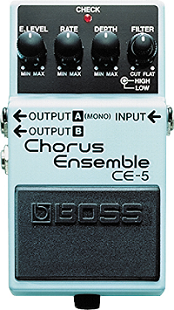Difference between revisions of "CE-5"
m (→Schematic) |
m (→Schematic) |
||
| Line 47: | Line 47: | ||
[[File:Boss_CE-5Schematic.png|center|frame|<div style="text-align:right">© Copyright 1991, Roland Corporation.</div>]] | [[File:Boss_CE-5Schematic.png|center|frame|<div style="text-align:right">© Copyright 1991, Roland Corporation.</div>]] | ||
| − | <div | + | <div class="center">[[:File:Boss_CE-5_ServiceManual.pdf|Boss CE-5 Service Manual]]</div> |
---- | ---- | ||
Revision as of 03:57, 20 February 2018
Boss CE-5 Chorus Ensemble Pedal. The CE-5 began as a continuation of the same chorus circuit as the Boss CE-2 and CE-3. The General Information section elaborates on how the CE-5 unfolded.
Thermionic Studios owns a CE-5 that is the older, discontinued, analog version. The Boss CE-5 Chorus Ensemble continues to be made, but is only available now as the "new" (post 2001) digital version. Opinions of the digital (post-2001) version of CE-5 tend not to be positive.
Controls
- Knob 1 - "E. Level": (Effect Level) This knob increases the amount of effect (wet) signal as compared to the dry sign
- Knob 2 - "Rate": This knob sets the speed of the modulation of the chorus; clockwise increases the speed.
- Knob 3 - "Depth": This knob sets the depth of the sweep of the chorus; clockwise increases the depth of the sweep.
- Knob 4 - "Filter": This is a dual-knob with an inner- and outer- knob, actually representing two tone controls.
- Inner Knob - "High": sets the volume of the treble tones, clockwise is more treble.
- Outer Knob - "Low": sets the volume of the bass tones, clockwise is more bass.
- Footswitch - "On/Off": Switch toggles the pedal on and off
- Output 1 - "Output A: This is the "mono" or wet+dry signal when Output B isn't being used. When Output B is used, Output A is pure wet signal.
- Output 2 - "Output B: This is the "stereo" or "dry only" output jack.
In a pinch it is possible to change the CE-5 from a Chorus pedal to a straight Vibrato pedal by connecting the cord that you're sending to the amplifier into Output A and take a small patch cord and plug it into Output B an then into nothing else. This forces all the wet signal through Output A and the dry signal into Output B. The wet signal is vibrato. When combined (summed) with a non-modulated dry signal, the result is heard by the human ear as a chorus sound. If using this trick be aware that without the effect level at Max, the wet signal will not have unity with the dry signal, causing a volume loss when engaged.
General Information
"CE" Product Line
One of the effects that Boss started their line of pedals with was the CE-1 Chorus Ensemble. This is the old 1970s grey "bean" shaped pedal with two button switches on it. This effect still gets rave reviews on both the lushness and subtlety of the chorus effect. Boss then continued the "CE" designation when they converted to the "classic" 1U stompbox format that we're familiar with today. Their first was the "CE-2 Chorus" which implemented the same circuit, but in a simpler 2-control mono-based effect. Boss then released the "CE-3 Chorus" with the distinctive black knobs with red line indicators (like the Boss VB-2), and stereo outputs. Boss then changed direction and chorus designation and released the "CH-1 Super Chorus".
"CE" then reappeared with the "CE-5 Chorus Ensemble". The earlier CE-5 models share the same pedigree (and MN3007 bucket-brigade delay chip) as the CE-2 and CE-3 and are valued for such. Later models of the CE-5 (labeled CE-5a on the PCB) discard the older analog design and use a new digital architecture. Panasonic stopped producing the MN3007 chip, causing Boss to change to the new digital architecture.
Modifications
It is also possible to modify the analog version of the CE-5 for greater function:
"Change C22 from 5pF to 22pF (or just solder a 22 pF across C22 on the back of the board). Increasing C22 increases the amount of delay through the bucket-brigade IC (analog delay). Increasing C22 to 22pF has a dramatic and wonderful effect on the depth of the chorus effect."
Phase Inversion
Pedal Manual
Schematic
- Additional Sources

